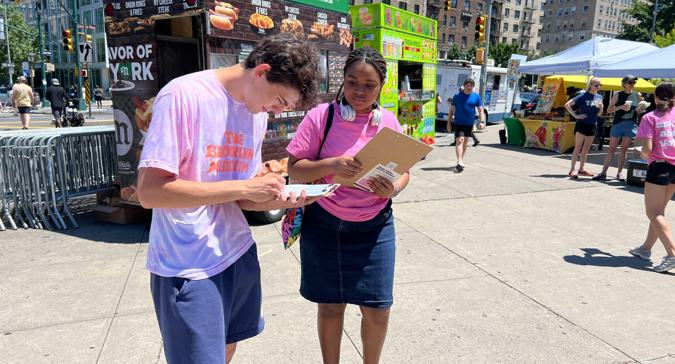紐約市選民分析
紐約市競選財務委員會每年都會深入研究選民資料,試圖瞭解有哪些紐約人參加投票,哪些人留在家中,以及我們可以從中學到什麼,以使未來的選舉對每個人都更有利。以下是 2024 年報告中的一些亮點。
年輕選民面臨參與障礙
- 紐約市還有很多工作要做,以確保年輕人投下選票。 2024 年 30 歲以下選民的投票率仍然很低,4 月份的投票率只有 3.7%,6 月份為 5.0%,11 月份則為 57.1%。青少年參與投票的障礙包括紐約排除無黨派選民的封閉的初選制度、有限的公民教育以及低預先登記率。預先登記可以讓 16 歲和 17 歲的人確保他們在 18 歲成年時就可以投票。
- 我們的青少年大使所做的研究強調這些問題,並呼籲更多的青少年選民參與和推廣。我們的 NYC Votes Youth Ambassadors(青少年大使)瞭解到了投票流程、紐約市民主的歷史沿革、如何參與地方政府和政治、如何教育並吸引年輕選民等等。

青少年大使正在登記選民
五分之一的選民被排除在外
- 在 2024 年不屬於任何政黨的選民基本上被排除在外。無黨派的選民往往比較年輕,有將近一半的人不到 40 歲,而且他們的投票率通常低於加入政黨的同齡人。無黨派選民佔紐約市登記選民的 21.1%。由於紐約實行封閉式初選制度,只有民主黨員可以在民主黨初選中投票,而只有共和黨員可以在共和黨初選中投票,因此有五分之一的紐約市選民無法在初選中投選票。
按政黨團體和年齡劃分的選民分佈

2020-2024 年大選按政黨劃分的投票人數

選舉次數過多導致選民疲勞
- 紐約人已經對投票疲勞略有感知。光是 2025 年的頭 4 個月,就已經舉行了 3 場特別選舉,而選民甚至還沒有參加市長初選的投票。為了減少選民疲勞並提高投票人數,紐約應盡可能合併選舉日期。選舉太過頻繁會加劇選民的疲勞,而協調選舉日期可以減少選民的疲勞,形成更具代表性的選民群體。減少選舉次數可能會提高投票人數。
抗議選票傳達了訊息
- 選民透過保持沉默來表達自己的意見。民主黨總統初選中空白選票票數明顯增加,有 14.8% 的選票未記錄。這個數字的激增與全國各地組織的抗議活動有關,抗議活動因人們對拜登總統處理加薩走廊衝突的方式感到憤怒而引發,相較於 2016 年的 1.1% 和 2020 年的 4.2%,空白選票票數急劇上升。紐約市五個行政區的空白選票投出率各不相同。 看看我們如何透過這段觀看次數超過 22 萬次的 Instagram 影片,在 2024 年吸引選民關注這個主題。
解釋 2024 年投票人數的地圖
想知道您的社區在 2024 中會有多少人投票?深入研究這些選民地圖。
- 全紐約市在 4 月和 6 月初選中的投票人數普遍偏低。這兩張圖說明兩次選舉的投票人數。
下一步是什麼?
2024 年選民分析報告明確呼籲大家採取行動,讓選舉造福所有人。為了在紐約市建立更強大、更具包容性的民主,我們必須吸引年輕和無黨派選民好讓他們更投入,減少選舉負擔,並使我們管理選民登記的方式現代化。若要詳細瞭解 CFB 如何建議解決這些問題、我們對投票趨勢的分析以及去年選舉的詳細人口統計資料,請閱讀完整報告!









